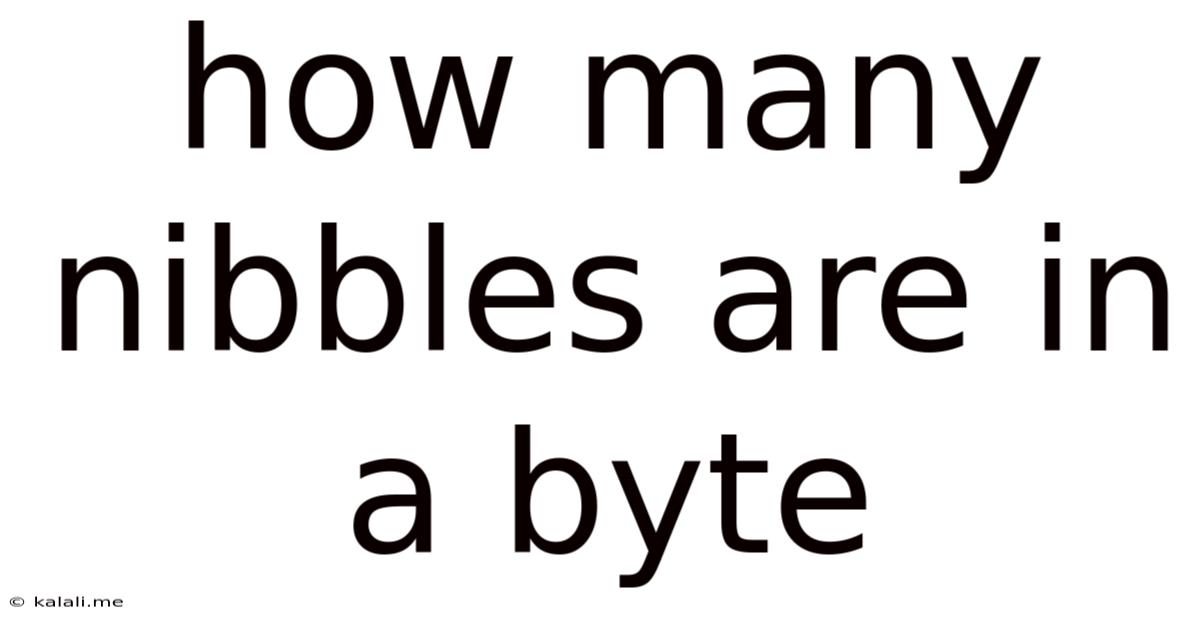How Many Nibbles Are In A Byte
Kalali
Jun 11, 2025 · 2 min read

Table of Contents
How Many Nibbles Are in a Byte? A Deep Dive into Data Units
This article will explore the relationship between nibbles and bytes, fundamental units in computer science. Understanding these units is crucial for anyone working with data storage, networking, or programming. We'll delve into their definitions, explore their practical applications, and clear up any confusion around these seemingly simple terms. By the end, you'll have a solid grasp of how many nibbles make a byte and why it matters.
What is a Nibble?
A nibble, also known as a half-byte, is a unit of data comprising four bits. Bits, short for binary digits, are the most fundamental units of information in computing, representing either a 0 or a 1. Think of a nibble as a small, discrete piece of data, often used to represent a single hexadecimal digit. Because a hexadecimal system uses base-16, each digit can be represented by four bits.
What is a Byte?
A byte is a unit of data comprising eight bits. It's a more commonly used unit than a nibble, often representing a single character in a text file or a small piece of data in a program. Bytes are the building blocks of larger data structures like kilobytes, megabytes, and gigabytes.
The Relationship: Nibbles and Bytes
Now, to answer the main question: There are two nibbles in one byte. Since a nibble is four bits and a byte is eight bits, a simple division (8 bits / 4 bits/nibble = 2 nibbles) reveals the relationship. This simple fact is fundamental to understanding data structures and how computers handle and process information.
Practical Applications of Nibbles and Bytes
While bytes are far more prevalent in everyday computing, nibbles do have specific applications:
- Hexadecimal Representation: Nibbles are perfectly suited to represent hexadecimal digits (0-9, A-F), making them useful for displaying memory addresses or data in a human-readable format. This is commonly used in debugging and low-level programming.
- Data Compression: In some specialized data compression algorithms, nibbles can be manipulated to achieve higher compression ratios, although this is less common in modern techniques.
- Network Protocols: Certain network protocols might utilize nibbles for specific control functions or data encoding, though this is less common than byte-level operations.
Beyond Nibbles and Bytes: Understanding Data Units
Understanding the relationship between nibbles and bytes is a stepping stone to grasping larger data units:
- Kilobyte (KB): 1024 bytes
- Megabyte (MB): 1024 kilobytes
- Gigabyte (GB): 1024 megabytes
- Terabyte (TB): 1024 gigabytes
- Petabyte (PB): 1024 terabytes
Conclusion
The seemingly simple question of "how many nibbles are in a byte?" leads us to a deeper understanding of the fundamental building blocks of digital information. Knowing that there are two nibbles in a byte provides a strong foundation for comprehending data storage, processing, and communication in the digital world. This knowledge is essential for programmers, network engineers, and anyone working with computers at a deeper, more technical level.
Latest Posts
Latest Posts
-
How Many Minutes Are In 40 Hours
Jul 01, 2025
-
How Many Cups Are In 16 Oz Of Sour Cream
Jul 01, 2025
-
How Many Quarters Are In 20 Dollars
Jul 01, 2025
-
How Many 1 3 Cups Equal A Cup
Jul 01, 2025
-
How Many Hours Are In Two Years
Jul 01, 2025
Related Post
Thank you for visiting our website which covers about How Many Nibbles Are In A Byte . We hope the information provided has been useful to you. Feel free to contact us if you have any questions or need further assistance. See you next time and don't miss to bookmark.